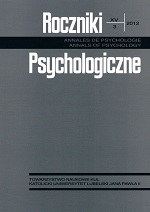Profilowa analiza dysfunkcji wykonawczych w diagnostyce neuropsychologicznej osób po udarze mózgu
Profile-based analysis of executive dysfunctions in neuropsychological examination of patients after stroke
Author(s): Daria Biechowska, Krzysztof Jodzio, Edyta Szurowska, Dariusz GąseckiSubject(s): Psychology
Published by: Towarzystwo Naukowe KUL & Katolicki Uniwersytet Lubelski Jana Pawła II
Keywords: executive functions; frontal lobes; control; inhibition; stroke
Summary/Abstract: Executive dysfunction (ExD) is a relatively common new diagnostic entity, which includes variety of symptoms of disorganized behavior, such as loss of ability to programming, initiating, and controlling ongoing actions. One of the most common origin of ExD is ischaemic stroke. Forty-three patients following unilateral hemispheric stroke were submitted to five tasks of executive functions, which is believed to measure an overall flexibility of problem solving (Wisconsin Card-Sorting Test), ability to switch of attention (Trail Making Test, Controlled Oral Word Association Test), and inhibitory control processes (Stroop Color-Word Test, go/no-go task). Subjects were divided into three anatomically-defined groups. The area of structural damage was limited entirely to the respective frontal lobe, subcortical region (mostly striatum, thalamus, and/or internal capsule) or posterior (non-frontal) cortices. All brain lesions were verified by CT or MR scan. Also, 25 healthy subjects took part in the study. Results showed: (a) patients’ group manifested variety of ExD which were heterogeneous with respect to severity and character, (b) the most severe deficit was disinhibition of automatic response in go/no-go task, (c) the patients with frontal or subcortical lesions had more difficulties controlling (inhibiting) ongoing verbal and motor responses than the patients with posterior cerebral lesions, (d) utility of profile-based analysis (pattern analysis of test scores) was emphasized in diagnosis of intraindividual heterogeneity in executive functioning after stroke. For instance, a strong association was found between extent of intraindividual differences of test scores and the overall severity of ExD.
Journal: Roczniki Psychologiczne
- Issue Year: 15/2012
- Issue No: 3
- Page Range: 83-100
- Page Count: 18
- Language: Polish

